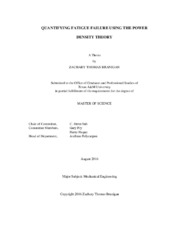| dc.description.abstract | Fatigue is the most common mechanical cause of engineering failures, but it is not well understood. Current methods of predicting fatigue failure rely on empirically-derived equations instead of having a truly scientific foundation. These have very high uncertainties, and they often do not consider the cycling frequency even though it has been proven to affect fatigue life. The power density theory is a new way of describing fatigue. It is based on the concept of power density, which is physically equivalent to the amount of power deposited into a unit volume. Power density results from changes in stress magnitude over time. Stress alternations that occur across a broad bandwidth of frequencies must be factored in. Higher frequencies coupled with faster changes in stress contribute more power density. Power density accumulates at every frequency and time, damaging the part. After this accumulation reaches the material’s power density threshold, a fundamental property of the material, it is expected to fail by fatigue.
A previously-published multiaxial vibration fatigue test was referenced and replicated using computer simulations, and the concept of power density was applied to predict its results. This served as a feasibility study for the theory, as well as an example of how to apply it. The power density response of the system was analyzed, and the failure locations were predicted for each of the ten load cases considered. The predicted failure locations followed the same trend as the experimental results. These results were promising, so more research is recommended to further test and develop the power density theory. Further examination of the theory could result in a better understanding of fatigue failure, improving engineering work across many industries. | en |


